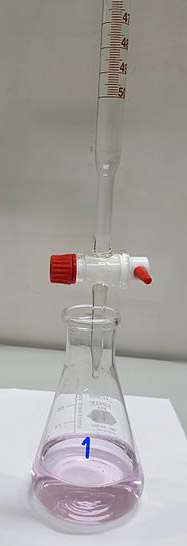Chemistry µGCSE:Solution Moles
10 quick questions - for GCSE and iGCSE
10 minutes maximum! Can you do it in 5? |
|||||||||||||||||
1. Which of these is the correct formula for the number of moles in solution?
| |||||||||||||||||
2. The amount, in moles, of KOH in 25.0cm3 of 0.150 mol/dm3 potassium hydroxide solution is:
| |||||||||||||||||
3. The volume of 0.500 mol/dm3 sulfuric acid which contains 0.0450 moles of sulfuric acid is:
| |||||||||||||||||
Q4+5. A student made a standard solution of sodium hydroxide by dissolving 10.0g of sodium hydroxide, NaOH, in distilled water to make 250cm3 of solution. [Mr: NaOH = 40]
|
H Padleckas | CC BY-SA 2.5 |
||||||||||||||||
4. Calculate the amount, in moles, of sodium hydroxide used.
| |||||||||||||||||
5. Calculate the concentration, in mol/dm3, of the sodium hydroxide solution produced.
| |||||||||||||||||
| 6. Hydrobromic acid can be neutralized using potassium hydroxide solution.
The equation for the reaction is: HBr(aq) + KOH(aq) → KBr(aq) + H2O |
|||||||||||||||||
Calculate the volume of 0.20 mol/dm3 potassium hydroxide solution needed to exactly neutralize 0.0020 moles hydrobromic acid.
|
|||||||||||||||||
Q7-10.
14.6cm3 of 0.200mol/dm3 sulfuric acid was required. |
 H Padleckas CC BY-SA 4.0 |
||||||||||||||||
The equation for the reaction is:
|
|||||||||||||||||
7. The most suitable pieces of apparatus for measuring the volumes of sodium hydroxide and sulfuric acid are:
| |||||||||||||||||
8. The amount, in moles, of sulfuric acid used in this titration is:
| |||||||||||||||||
9. The amount, in moles, of sodium hydroxide used to neutralize the sulfuric acid is:
| |||||||||||||||||
10. The concentration, in mol/dm3, of the sodium hydroxide solution used to neutralize this sulfuric acid is:
| |||||||||||||||||